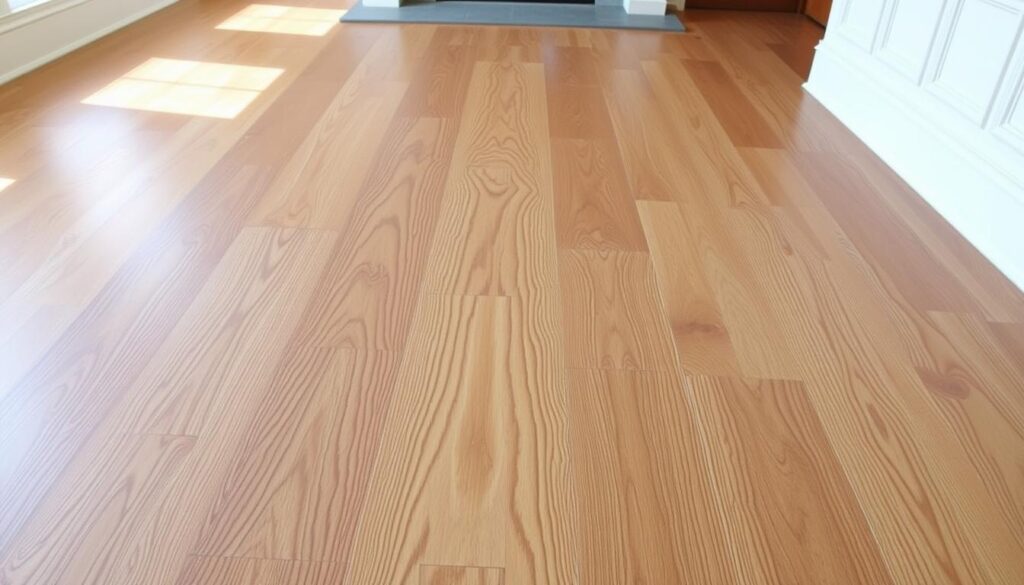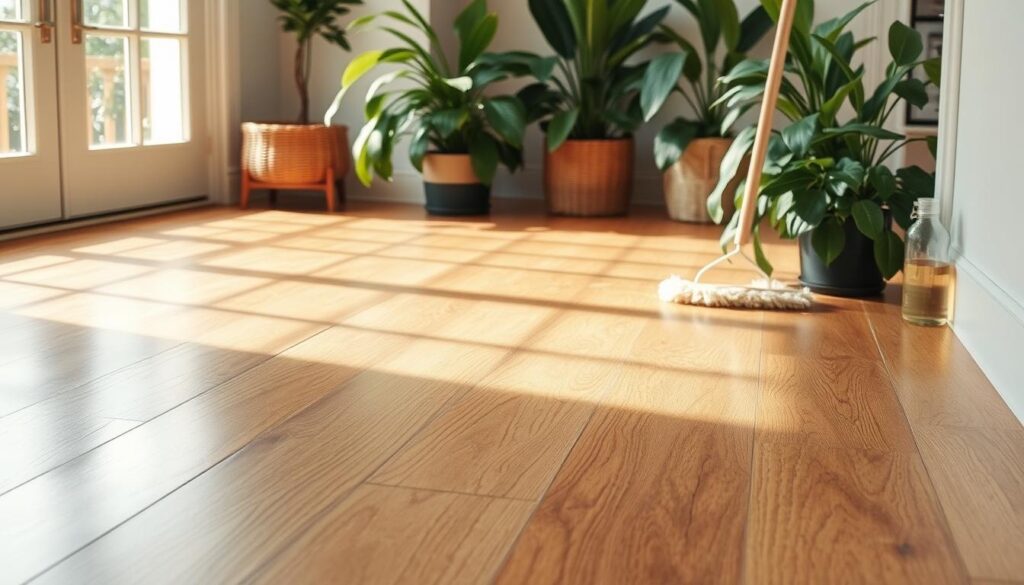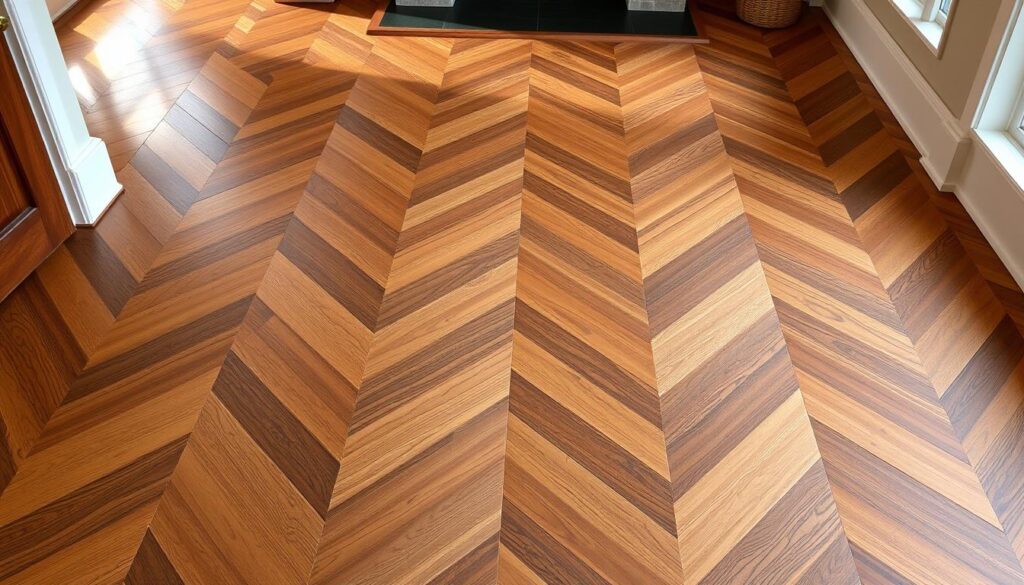Discover premium tongue and groove flooring options that combine durability with elegant design. Transform your home with our selection of quality wood and engineered solutions
Enhance your home’s beauty and durability with premium tongue and groove flooring. Made from the finest wood, it combines style and strength. It’s ideal for those wanting an elegant, lasting home design.
Whether you’re building or renovating, this flooring can make any room stunning. It showcases your personal taste and refined aesthetic.

Key Takeaways
- Discover the superior craftsmanship and interlocking system of tongue and groove flooring
- Explore the diverse range of wood species available to match your design preferences
- Understand the essential factors to consider for a successful tongue and groove installation
- Weigh the benefits of professional installation versus a DIY approach
- Maintain the timeless beauty of your wood floors with proper care and maintenance
Understanding Tongue and Groove Flooring Basics
Tongue and groove (T&G) flooring is a top pick for those wanting a strong and lasting wood floor. It’s made of interlocking boards that make a smooth, stable floor. Let’s dive into what makes T&G flooring special.
Components of T&G Construction
The main parts of a tongue and groove floor are:
- Tongue: A part that sticks out on one board, fitting into the groove of the next.
- Groove: A space on the other board that takes the tongue of the first.
- Edge: Sharp, angled parts that help the boards fit together tightly.
How the Interlocking System Works
The tongue and groove design makes a strong, tight system. Each board’s tongue fits into the groove of the next, making a solid floor. This method keeps the floor stable, perfect for busy areas.
Benefits of This Installation Method
T&G flooring has many perks over other methods. Here are some:
- Enhanced Stability: It’s very strong, lasting longer than other floors.
- Seamless Appearance: The tight joints make the floor look smooth and even.
- Ease of Installation: It’s quicker and easier to put in than other types.
- Increased Longevity: It prevents problems like gaps and warping, making it last longer.
Knowing about tongue and groove flooring helps homeowners choose the best wood floor. For more info or to talk about your options, call Timber Tropics at +6282332572828 or email info@timbertropics.com.
Different Wood Species for Your Flooring Project
Choosing the right wood for your tongue and groove flooring is exciting. You have many options, from classic hardwoods to new engineered wood types. Each type has its own look and feel, making your home more beautiful and durable. Whether you love the classic look of domestic hardwoods or the unique beauty of exotic woods, knowing the differences helps you choose the best.
Hardwood Flooring Types
Hardwood floors are loved for their natural beauty and strength. Oak, maple, and hickory are popular choices. They are known for being durable and lasting long, perfect for busy areas.
Engineered Wood Flooring Options
Engineered wood flooring is great for those who want solid hardwood but need more stability. It has a real wood top layer over plywood or fiberboard. Options like bamboo and acacia work well in many places, even where humidity changes.
Exotic Wood Species
Exotic woods like Brazilian cherry and Tigerwood add luxury to your floors. They have unique patterns and colors that make a room stand out. While they cost more, they add value and beauty to your home.
| Wood Species | Characteristics | Suitability |
|---|---|---|
| Oak | Durable, with a classic, versatile appearance | Ideal for high-traffic areas, suitable for a wide range of design styles |
| Maple | Lightweight, with a smooth, uniform grain pattern | Suitable for both modern and traditional spaces, excellent for high-traffic areas |
| Bamboo | Environmentally-friendly, with a unique, contemporary aesthetic | Versatile for various interior designs, resilient to moisture and humidity |
| Brazilian Cherry | Exotic, with a rich, reddish-brown color and distinct grain | Adds a touch of elegance to any space, suitable for formal or high-end interiors |
Whether you have a specific style in mind or a budget to stick to, there’s a wood type for you. Knowing what each wood offers helps you pick the perfect flooring. You’ll get a floor that’s not only beautiful but also durable and fits your home’s style.
Video source from youtube
Factors Affecting Tongue and Groove Installation
Installing tongue and groove flooring needs careful attention to several key factors. These include subfloor preparation, moisture control, and wood acclimation. Each plays a crucial role in a successful, lasting installation.
Subfloor Requirements
The subfloor is the base for your tongue and groove flooring. It’s vital to prepare it properly to avoid problems like unevenness or squeaks. Make sure the subfloor is clean, level, and free of debris or protrusions.
Moisture Control Considerations
Moisture can harm wood flooring. It’s important to use moisture barriers to protect your flooring. Check the subfloor’s moisture levels and use a vapor barrier or moisture-resistant sealant to keep it dry and stable.
Acclimation Period Guidelines
- Let the wood flooring acclimate in the installation environment for at least 72 hours before installing.
- Stack the wood planks in the room where they’ll be installed, ensuring good air circulation.
- Keep an eye on the wood’s moisture content and adjust the acclimation time as needed.
By focusing on these key factors, you can set up a successful tongue and groove flooring installation. Remember, proper preparation and attention to detail are essential for a stunning, durable wood floor in your home.
| Subfloor Preparation | Moisture Control | Acclimation Period |
|---|---|---|
| Clean, level, and free of debris | Install vapor barrier or moisture-resistant sealant | Minimum 72 hours, monitor moisture content |
Cost Analysis and Budgeting Guide
Choosing quality tongue and groove flooring for your home is a big decision. It needs careful financial planning. We’ll look at the costs, from the start to keeping it up over time.
The flooring cost comparison shows the initial wood floor pricing changes a lot. It depends on the wood type, grade, and design. On average, materials cost between $4 to $12 per square foot. Installation costs range from $3 to $8 per square foot, based on the project’s complexity and local labor costs.
| Cost Factor | Estimated Range |
|---|---|
| Materials (per sq. ft.) | $4 – $12 |
| Installation (per sq. ft.) | $3 – $8 |
| Total Cost (per sq. ft.) | $7 – $20 |
Remember, these are just estimates. Costs can change based on your project. For a better idea, talk to a flooring expert or get quotes from different suppliers.
When planning your budget, remember to include subfloor prep, moisture control, and possibly professional installation. Also, think about long-term upkeep costs. This way, your flooring will last for many years.
Understanding the flooring cost comparison helps you budget wisely. This way, you can choose flooring that fits your budget and home improvement plans. For personalized advice, contact Timber Tropics at +6282332572828 or info@timbertropics.com.
Professional Installation vs. DIY Approaches
Choosing between DIY and professional installation for tongue and groove flooring is a big decision. Each option has its own benefits and things to consider. Knowing the differences can help you decide what’s best for your home.
Tools Required for Installation
DIY installation needs specific tools. You’ll need a miter saw, jamb saw, flooring nailer, pry bar, hammer, and more. Getting and learning to use these tools takes time and money.
Common Installation Mistakes to Avoid
- Improper subfloor preparation
- Failure to account for expansion and contraction
- Uneven board placement and alignment
- Damage to the tongue and groove during installation
- Inadequate fastening or improper use of adhesives
When to Call the Professionals
For big or complex flooring jobs, think about hiring pros. They have the skills, tools, and experience for a smooth, lasting job. If you’re worried about subfloor prep, acclimation, finish quality, or avoiding DIY mistakes, go for professional help.
- Ensuring a level and properly prepared subfloor
- Properly acclimating the flooring to your home’s environment
- Achieving a consistent and aesthetically pleasing finish
- Avoiding common DIY pitfalls that could compromise the longevity of your floor
Deciding between DIY and professional help depends on your skills, the project’s complexity, and your confidence in the result. Think about the pros and cons to choose the best option for your home.
For professional flooring installation or questions, call us at +6282332572828 or email info@timbertropics.com. Our team is ready to help you find the perfect tongue and groove flooring for your home.
Maintaining Your Wood Floor’s Beauty
Keeping your tongue and groove wood floors looking great is key. It helps them stay beautiful for years. This guide will teach you how to keep your floors in top shape.
Effective Cleaning Methods
Cleaning your floors regularly is the first step. Start by sweeping or vacuuming to get rid of dirt. For a deeper clean, use a damp mop with a cleaner that’s safe for wood.
Be careful not to use too much water. It can harm the wood. Clean spills right away to avoid stains.
Protective Measures
Protecting your floors from daily damage is important. Use area rugs or mats in busy areas to prevent scratches. Felt pads under furniture legs can also help.
Check your floors often for wear and tear. Fix any problems quickly to keep them looking good.
Periodic Refinishing
Even with good care, your floors might need refinishing over time. This means sanding and applying a new finish. For the best results, consider hiring a professional.
By following these tips, you can keep your floors beautiful and durable. For any questions, contact Timber Tropics at +6282332572828 or info@timbertropics.com.

| Cleaning Technique | Frequency | Benefits |
|---|---|---|
| Sweep/Vacuum | Weekly | Removes loose dirt and debris |
| Damp Mop with Wood-Safe Cleaner | Monthly | Deeper cleaning to maintain shine |
| Spot Cleaning | As Needed | Prevents stains and discoloration |
| Refinishing | Every 5-10 Years | Restores the floor’s original luster |
Environmental Impact and Sustainability
Choosing the right flooring for your home is important. Sustainable options like tongue and groove wood help reduce your carbon footprint. They support a greener future. Knowing about eco-friendly wood and certification standards helps you make a choice that’s good for the planet.
Eco-Friendly Wood Sources
Choosing wood from responsible sources is key. Look for wood from well-managed, renewable forests. The Forest Stewardship Council (FSC) certification is a good sign. It means the wood comes from forests that are protected and managed well.
By picking FSC-certified sustainable flooring, you help keep our forests healthy. This choice supports the environment and the people who live there.
Certification Standards
- FSC (Forest Stewardship Council) certification: This globally recognized standard ensures that the wood is sourced from responsibly managed forests, promoting biodiversity and responsible forestry practices.
- GREENGUARD certification: This certification verifies that the flooring materials meet strict chemical emission standards, providing a healthier indoor environment for you and your family.
- Eco-friendly wood certifications: Keep an eye out for other eco-labels, such as Rainforest Alliance, that signify a commitment to sustainable forestry and environmentally conscious production.
| Certification | Description | Benefits |
|---|---|---|
| FSC | Forest Stewardship Council certification ensures responsible forest management. | Preserves biodiversity, protects indigenous communities, and promotes sustainable harvesting practices. |
| GREENGUARD | Certifies that building materials, including flooring, meet strict chemical emission standards. | Contributes to improved indoor air quality and a healthier living environment. |
| Rainforest Alliance | Certification for products sourced from responsibly managed forests and farms. | Supports the conservation of natural resources and the wellbeing of local communities. |
Choosing FSC-certified and eco-friendly wood makes your floors beautiful and durable. It also helps the planet. Contact Timber Tropics today at +6282332572828 or info@timbertropics.com. Learn more about our sustainable flooring options and how to choose eco-friendly for your home.
Design Ideas and Style Integration
Adding tongue and groove flooring to your home can make it look better. You can choose from classic herringbone to modern chevron designs. This makes your floors look great and match your home’s style.
Tongue and groove flooring is perfect for many interior designs. It works well with rustic farmhouse looks or modern, simple designs. The right pattern and color can make your room look even better.
To make your floors stand out, pair them with matching decor. Think about using natural wood, neutral colors, and bold lights. This mix of textures and colors can make your space look beautiful and reflect your taste.

- Herringbone patterns for a timeless and elegant look
- Chevron designs for a modern, geometric aesthetic
- Wider plank widths to create a dramatic, spacious feel
- Muted, earthy tones to complement nature-inspired palettes
- Contrasting wood tones for a visually striking and dynamic effect
By choosing tongue and groove flooring, you can make your home look amazing. It shows off your style and makes your home look better.
For more info or design help, call us at +6282332572828 or info@timbertropics.com. We’re ready to help make your dream home a reality.
Dealing with Common Issues and Repairs
Keeping your wood floors beautiful and lasting is key. Even the best cared-for floors can face problems. Knowing how to fix squeaky floors and manage gaps is crucial for maintaining your hardwood floors.
Addressing Squeaky Boards
Squeaky floors can be annoying. Start by checking the subfloor for loose nails or screws. Tightening these might solve the problem. If squeaks continue, use a floor repair silicone or lubricant to reduce friction and stop the squeaks.
Managing Gaps and Expansion
- Watch for signs of expansion or contraction in your wood floors. Gaps between boards often come from temperature and humidity changes.
- To fix expanding gaps, use a floor filler or wood putty. Follow the manufacturer’s guide for best results.
- For big expansion issues, get a professional wood floor repair expert. They can fix your tongue and groove flooring right.
Knowing how to fix common problems can keep your wood floors looking great. This protects your investment for many years.
| Floor Repair Technique | Typical Cost | Difficulty Level |
|---|---|---|
| Tightening Loose Fasteners | $50 – $100 | Easy |
| Applying Floor Repair Silicone | $75 – $150 | Moderate |
| Filling Expansion Gaps | $100 – $300 | Moderate |
| Professional Floor Repair | $500 – $2,000+ | Difficult |
For complex wood floor issues, always get a pro. They can figure out the problem and fix it effectively.
Need help with your wood floor repairs? Contact Timber Tropics. Call us at +6282332572828 or email info@timbertropics.com.
Conclusion
Tongue and groove flooring is a great choice for your home. It’s durable and easy to install. Plus, it adds a timeless beauty to any room.
Learning about tongue and groove flooring helps you make a smart choice. You can pick the right wood species and plan the installation. This way, you can have a beautiful and lasting floor in your home.
If you need help with your flooring project, contact Timber Tropics. Call +6282332572828 or email info@timbertropics.com. Our experts are ready to help you get the perfect floors for your home.
FAQ
What are the key features of tongue and groove flooring?
Tongue and groove flooring is known for its durability and seamless look. It’s made to last, with a system that prevents warping and gaps. This makes it a strong choice for your floors.
How does the tongue and groove installation process differ from other flooring types?
Installing tongue and groove flooring is a bit more challenging. You need to align and lock the boards together. This creates a tight, uniform floor that’s stronger than others.
What wood species are available for tongue and groove flooring?
You can find tongue and groove flooring in many hardwood and engineered wood types. Options include oak, maple, hickory, and exotic woods like Brazilian cherry and bamboo. Each type has its own look and durability.
How do I prepare the subfloor for tongue and groove installation?
Preparing the subfloor is key for a successful installation. Make sure it’s clean, level, and dry. This prevents problems like squeaks and warping later on.
What are the cost considerations for tongue and groove flooring?
The cost of tongue and groove flooring varies. It depends on the wood type, project size, and whether you install it yourself or hire a pro. While it’s pricier than some options, its durability and beauty make it worth it.
When should I hire a professional installer for my tongue and groove flooring project?
If you’re not sure about installing tongue and groove flooring yourself, consider hiring a pro. They have the tools and know-how to ensure a perfect job.
How do I maintain the beauty and longevity of my tongue and groove wood floors?
To keep your floors looking great, clean them regularly and use the right products. Fix any problems quickly and consider refinishing them to keep them looking new.
Are there any eco-friendly or sustainable options for tongue and groove flooring?
Yes, there are eco-friendly options like floors made from reclaimed or responsibly sourced wood. Look for certifications like the Forest Stewardship Council (FSC) to ensure you’re making an environmentally friendly choice.
How can I integrate tongue and groove flooring into my home’s overall design?
Tongue and groove flooring fits well with many design styles. Its natural beauty and clean lines make it versatile, complementing both traditional and modern decor.
How do I address common issues with my tongue and groove flooring, such as squeaky boards or gaps?
For small problems like squeaky boards or gaps, you can try DIY fixes. But for bigger issues, it’s best to get help from a flooring expert. They can fix the problem right and ensure your floors last.
Related article : Thick Rubber Flooring Guide: Protect Your Hardwood Floor
